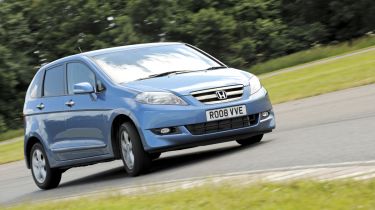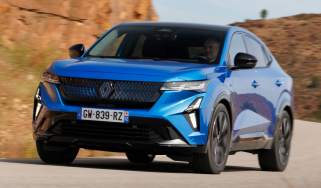Honda FR-V eS
Quirky MPV offers space for six in a quality package.
Six-seaters are a rare breed, but the Honda FR-V shows how practical they can be. It arrived in 2004 with three-abreast seating over two rows in the style of Fiat’s Multipla.
The major advantage of this configuration is that even when all the seats are occupied, there’s still plenty of luggage space, so the Honda has a generous 439-litre boot capacity. And due to its wide track, the handling is good compared with rivals.
That’s not to say the FR-V is perfect, though. Access can be tricky, for starters – the body is so wide that when parked in a standard bay, there isn’t much space to swing open the doors. And then there’s the issue of who sits alongside the driver.
With three people up front, the middle passenger has to rub shoulders with the person behind the wheel, which makes changing gears a cosy affair. As a result, it’s always the last place to be filled – and while children might relish the chance to sit up front, adults will prefer to leave it empty if possible.
The rear of the cabin is much more comfortable, as the boxy dimensions provide plenty of leg and headroom. The solidly built interior feels as if it is able to stand up to the rigours family life, too. With a full complement of passengers, the FR-V makes financial sense, and it scores well in terms of costs and CO2 output.
Although the £17,540 price sounds expensive, it works out at £2,923 per seat – a figure only the huge Hyundai can beat. And CO2 emissions of 29.5g/km per seat rank the Honda third here.
So it’s a shame that these impressive figures are undone when every one of the six seats is occupied. Adding four extra bodies has a marked effect on the FR-V. Most notably, the 1.8-litre petrol engine has to work hard to haul the extra weight. When fully laden, it took two seconds longer to cover 0-60mph, at 12.1 seconds.
Braking ability was also compromised: from 70mph, it took us 51.7 metres to bring the Honda to a halt – 2.5 metres longer than when there were only two people on board. That equates to a 5.1 per cent rise – one of the worst on test.
With two seats occupied, the FR-V is good to drive, offering precise steering and slick changes through the neat dash-mounted gearlever.
It feels more like a family hatchback than a tall-riding people carrier, largely thanks to the comfortable ride and tidy handling. In this test, Honda’s excellent 2.2-litre i-CTDi diesel variant might have performed better as it has more torque and lower CO2 emissions – but it also costs more to buy.
So is the petrol model good enough to make six seats the ultimate cabin capacity in the final analysis?







